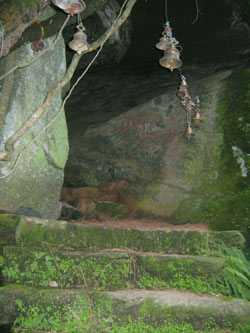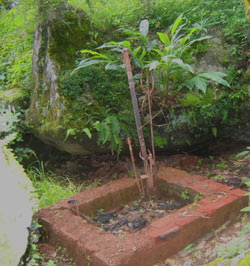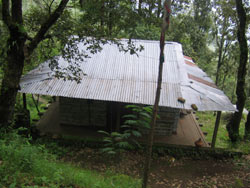. | ||
At Paharpani, at a distance of 1 km below the roadhead, is an ancient maha-gufa. It is also known as gupt-gufa, or among the sacred secret caves of the Himalayas. Currently, it is one of Maharishi Gorakh Babaji's main tapasya-sthals. Nearby is his small kutia and also the yagyasthan where he has held yagyas for the villagers. Since Babaji started spending time here at regular intervals and performed different anusthans for the nearby villagers, the local people are now aware of the gufa. In this mahagufa, there are several caves nearby, which can be used for purposes of intense sadhana. The chief gufa is deep and the path is narrow and perilous. As is customary, locals do not venture beyond the entrance to the mandir from where they offer worship. In the mandir there is a dhuna or sacred firepit, a small idol of Devi, and symbols of Ganesh-ji, Bhairav Nath and a Shiva lingam from Alaknanda, Badrinath, which have been established and spiritually awakened by Babaji. An ancient diya is also at the dhuna. Next to the main gufa is a cave known as Bagh Gufa or Naga Gufa, because during Sri Gorakh Babaji's prolonged tapasya there, a bagh or tiger/leopard stayed there, as also a Naga Deva, or sacred snake, protectors of tapaswi yogis during their tapasya kaal or period of intense austerities. It is common for baghs and bhalus or tigers and bears to roam these areas and they are frequently sighted. In this mahagufa, Mahavatar Haidakhandi Babaji, among other yogis have also done tapasya at a time when this was in the deep dense forests, before there was any village settlement here. Legend claims this was also used by the Pandavas in the days of the Mahabharat. | ||
Thursday, December 9, 2010
Close to the gufa is Sri Gorakh Babaji's tapasya-dhuni, called Manasarovar Kailash dhuni.
Subscribe to:
Post Comments (Atom)



Please publish more about the other sacred places, like, Kalyan Gadha, Satara. By doing this other Nath Bhaktas will be benifitted by visiting those sacred places.
ReplyDeleteThanks.
Jai Guru Gorakshanath ji ka Adesh !!!!